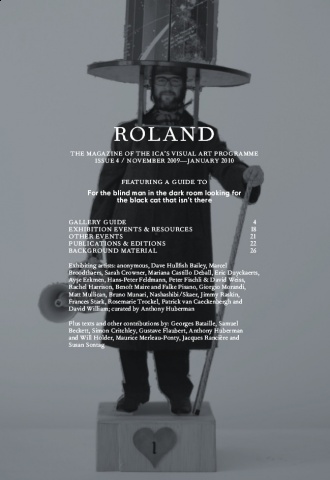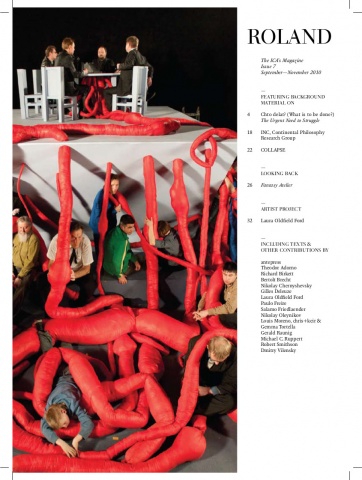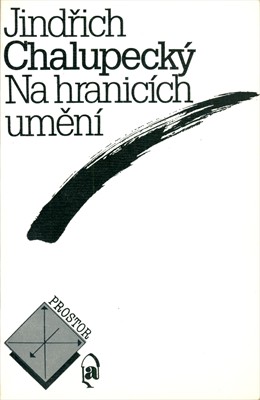Roland, The ICA’s Magazine, 1-9 (2009-2011)
Filed under magazine | Tags: · art, art criticism, contemporary art, london, music


Roland Issue 1: Talk Show (May 2009)
A guide to Talk Show exhibition, with texts and contributions by Malcolm Goldstein, Ernest Robson, Will Holder, Robert Ashley, Alvin Lucier, Ricardo Basbaum, Anne Karpf, Susan Blackmore, Konstantin Raudive,Will Bradley, Gertrude Stein, Joan La Barbara, Marc Hatzfeld, Marshall Mcluhan, Mikhail Yampolsky, Chris Mann, Hélène Cixous, BS Johnson, Ja Chung and Q Takedi Maeda, Paul Virno and Shigeru Matsui.
Roland Issue 2: Poor. Old. Tired. Horse. (June-August 2009)
A guide to the Poor. Old. Tired. Horse. exhibition with texts and contributions by Charlotte Bonham-Carter, Augusto de Campos, Lewis Carroll, Michelle Cotton, Douglas Coupland, Eugen Gomringer, George Herbert, Joseph Kosuth, Liz Kotz, Giles Round, Stephen Scobie, Tris Vonna-Michell and William Carlos Williams.
Roland Issue 3: Rosalind Nashashibi (September-October 2009)
A guide to Rosalind Nashsahibi with texts and contributions by Claire Denis, Anselm Franke, Martin Herbert, Mark Leckey, G. Ch. Lichtenberg, Thomas Mann, Jonas Mekas, Pier Paolo Pasolini and Marcel Proust.
Roland Issue 4: For the blind man… (December 2009)
A guide to the exhibition For the blind man in the dark room looking for the black cat that isn’t there with contributions by Georges Bataille, Samuel Beckett, Simon Critchley, Gustave Flaubert, Anthony Huberman and Will Holder, Maurice Merleau-Ponty, Jacques Rancière and Susan Sontag.
Roland Issue 5: Billy Childish (February-April 2010)
A guide to Billy Childish: Unknowable but Certain with texts and contributions by Max Beckmann, Richard Birkett, Neal Brown, Charles Bukowski, Martin Clark, Louis-Ferdinand, Céline, Bo Diddley, Knut Hamsun, Matthew Higgs, Jutta Koether and Robert Walser
Roland Issue 6: Oscar Tuazon (June-August 2010)
The sixth issue of ROLAND features highlights from across the institute’s programme including the solo exhibition by Oscar Tuazon, the post-punk band Gang of Four, a symposium on the politics of community, the release of Harmony Korine’s Trash Humpers, and the London International Festival of Theatre.
Roland Issue 7: Chto delat? (What is to be done?) (September-November 2010)
This publication includes introductions to and background material on the Chto delat? exhibition The Urgent Need to Struggle, the release in our cinema of documentary film Collapse and a series of seminars and talks organised by InC, Continental Philosophy Research Group. We also take a look back at May’s architectural workshop Fantasy Atelier, and feature new work from Laura Oldfield Ford.
Roland Issue 8: Rhythm Section (November 2010 – February 2011)
This issue highlights the return of Bloomberg New Contemporaries to the ICA; Rhythm Section, a five-day event that explores the experimental potential of the percussive technique; an in-depth look at the work of artist-filmmaker Gustav Deutsch; a residency with London-based architects 6a, and a debate on the position of painting within contemporary art.
Roland Issue 9: Nathaniel Mellors (February-May 2011)
This issue of ROLAND includes introductions and information on Nathaniel Mellors, Birds Eye View Film Festival as well as the The Last of the Red Wine, Notation & Interpretation, and Shunt Live Weekends.
Publisher Institute of Contemporary Arts, London
Comments (3)Jindřich Chalupecký: Na hranicích umění. Několik příběhů (1987/1990) [Czech]
Filed under book | Tags: · art, art criticism, art history, czech republic, czechoslovakia, slovakia

Výtvarný a literární kritik a historik umění Jindřich Chalupecký v knize portrétuje české a slovenské umělce Vladimíra Boudníka, Jiřího Balcara, Jiřího Koláře, Ladislava Nováka, Milana Knížáka, Alexe Mlynárčika, Evu Kmentovou, Petra Štemberu a Jana Mlčocha.
First published by K. Jadrný, Munich, 1987
Publisher Prostor, 1990
Arkýř series
ISBN 8085190060
160 pages
Jindřich Chalupecký: Úděl umělce. Duchampovské meditace (1998) [Czech]
Filed under book | Tags: · art, art criticism, art history, avant-garde, dada

V Marcelu Duchampovi nachází Jindřich Chalupecký nejdůležitěší a nejvlivnější osobnost světového moderního umění. Práce, z níž je cítit autorova hluboká zaujatost tématem, poprvé u nás podává souhrnný pohled na Marcela Duchampa, bez něhož je veškeré umění 20. století nemyslitelné. Kniha, která je výsledkem mnohaletého autorova studia, vychází doplněna řadou barevných a černobílých vyobrazení.
Epilogue: Pavla Pečinková
Publisher Torst, Prague, 1998
ISBN 8072150502
456 pages
PDF (no OCR)
Comment (0)
